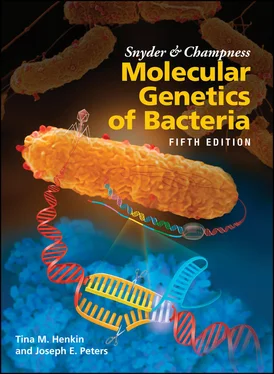Antibiotics That Block Precursor Synthesis
As discussed above, DNA is polymerized from the deoxynucleoside triphosphates. Any antibiotic that blocks the synthesis of these deoxynucleotide precursors will block DNA replication.
Inhibition of dihydrofolate reductase
Some of the most important precursor synthesis blockers are antibiotics that inhibit the enzyme dihydrofolate reductase. One such compound, trimethoprim, works very effectively in bacteria, and the antitumor drug methotrexate (amethopterin) inhibits the dihydrofolate reductase of eukaryotes. Methotrexate is used as an antitumor agent, among other uses such as in the treatment of inflammatory arthritis.
Antibiotics like trimethoprim that inhibit dihydrofolate reductase kill the cell by depleting it of tetrahydrofolate, which is needed for many biosynthetic reactions. This inhibition is overcome, however, if the cell lacks the enzyme thymidylate synthetase, which synthesizes dTMP; therefore, most mutants that are resistant to trimethoprim have mutations that inactivate the thyA thymidylate synthetase gene. The reason is apparent from the pathway for dTMP synthesis shown in Figure 1.5. Thymidylate synthetase is solely responsible for converting tetrahydrofolate to dihydrofolate when it transfers a methyl group from tetrahydrofolate to dUMP to make dTMP. The dihydrofolate reductase is the only enzyme in the cell that can restore the tetrahydrofolate needed for other biosynthetic reactions. However, if the cell lacks thymidylate synthetase, there is no need for a dihydrofolate reductase to restore tetrahydrofolate. Therefore, inhibition of dihydrofolate reductase by trimethoprim has no effect, thus making thyA mutant cells resistant to the antibiotic. Of course, if the cell lacks a thymidylate synthetase, it cannot make its own dTMP from dUMP and must be provided with thymidine in the medium so that it can replicate its DNA.
There is more than one mechanism by which cells can achieve trimethoprim resistance. They can have an altered dihydrofolate reductase to which trimethoprim cannot bind, or they can have more copies of the gene so that they make more enzyme than there is trimethoprim to inhibit it. Some plasmids and transposons carry genes for resistance to trimethoprim. These genes encode dihydrofolate reductases that are much less sensitive to trimethoprim and so can act even in the presence of high concentrations of the antibiotic.
Inhibition of ribonucleotide reductase
The antibiotic hydroxyurea inhibits the enzyme ribonucleotide reductase, which is required for the synthesis of all four precursors of DNA synthesis ( Figure 1.5). The ribonucleotide reductase catalyzes the synthesis of the deoxynucleoside diphosphates dCDP, dGDP, dADP, and dUDP from the ribonucleoside diphosphates, an essential step in deoxynucleoside triphosphate synthesis. Mutants resistant to hydroxyurea have an altered ribonucleotide reductase.
Competition with deoxyuridine monophosphate
5-Fluorodeoxyuridine and the related 5-fluorouracil have monophosphate forms resembling dUMP, the substrate for thymidylate synthetase. By competing with the natural substrate for this enzyme, they inhibit the synthesis of deoxythymidine monophosphate. Mutants resistant to these compounds have an altered thymidylate synthetase. These are useful antibiotics for the treatment of fungal, as well as bacterial, infections.
Antibiotics That Block Polymerization of Deoxynucleotides
The polymerization of deoxynucleotide precursors into DNA would also seem to be a tempting target for antibiotics. However, there seem to be surprisingly few antibiotics that directly block this process. Most antibiotics that block polymerization do so indirectly, by binding to DNA or by mimicking the deoxynucleotides and causing chain termination, rather than by inhibiting the DNA polymerase itself.
Deoxynucleotide precursor mimics
Dideoxynucleotides are similar to the normal deoxynucleotide precursors, except that they lack a hydroxyl group on the 3′ carbon of the deoxynucleotide. Consequently, they can be incorporated into DNA, but then replication stops because they cannot link up with the next deoxynucleotide. These compounds are not useful antibacterial agents, probably because they are not phosphorylated well in bacterial cells. However, this property of prematurely terminating replication has made them the basis for one of the first methods for DNA sequencing (see chapter 13).
Mitomycin C blocks DNA synthesis by cross-linking the guanine bases in DNA to each other. Sometimes the cross-linked bases are in opposing strands. If the two strands are attached to each other, they cannot be separated during replication. Even one cross-link in DNA that is not repaired prevents replication of the chromosome. This antibiotic is also a useful antitumor drug, probably for the same reason. DNA cross-linking also affects RNA transcription.
Antibiotics That Affect DNA Structure
Acridine dyes
The acridine dyes include proflavine, ethidium, and chloroquine. These compounds insert between the bases of DNA and thereby cause frameshift mutations and inhibit DNA synthesis. Their ability to insert themselves between the bases in DNA has made acridine dyes very useful in genetics and molecular biology. Some of these applications are discussed in later chapters. In general, acridine dyes are not useful as antibiotics because of their toxicity due to their ability to block DNA synthesis in the mitochondria of eukaryotic cells. Some members of this large family of antibiotics have long been used as antimalarial drugs because of their ability to block DNA synthesis in the mitochondria (kinetoplasts) of trypanosomes. This is the basis for the antimalarial activity of the tonic water in a gin and tonic.
5-Bromodeoxyuridine (BUdR) is similar to thymidine and is efficiently phosphorylated and incorporated in its place into DNA. However, BUdR incorporated into DNA often mispairs and increases replication errors. DNA containing BUdR is also more sensitive to some wavelengths of ultraviolet (UV) light (which makes BUdR useful in enrichment schemes for isolating mutants [see chapter 3]). Moreover, DNA containing BUdR has a different density from DNA exclusively containing thymidine (another feature of BUdR that is useful in experiments).
Antibiotics That Affect Gyrase
Many antibiotics and antitumor drugs affect topoisomerases. The type II topoisomerase, gyrase, in bacteria is a target for many different antibiotics. Because this enzyme is similar among all bacteria, these antibiotics have a broad spectrum of activity and kill many types of bacteria.
Nalidixic acid specifically binds to the GyrA subunit, which is involved in cutting the DNA and in strand passage. This activity makes nalidixic acid and its many derivatives, including oxolinic acid and chloromycetin, very useful antibiotics. Another antibiotic that binds to the GyrA subunit, ciprofloxacin, is used for treating gonorrhea, anthrax, and bacterial dysentery. However, because these antibiotics can induce prophages, they may actually make some diseases worse (see chapter 7).
The mechanism of killing by these antibiotics is not completely understood. They are known to cause degradation of DNA and can cause the DNA to become covalently linked to gyrase, presumably by trapping it in an intermediate state in the process of strand passage. Bacteria resistant to nalidixic acid have an altered gyrA gene.
Читать дальше











